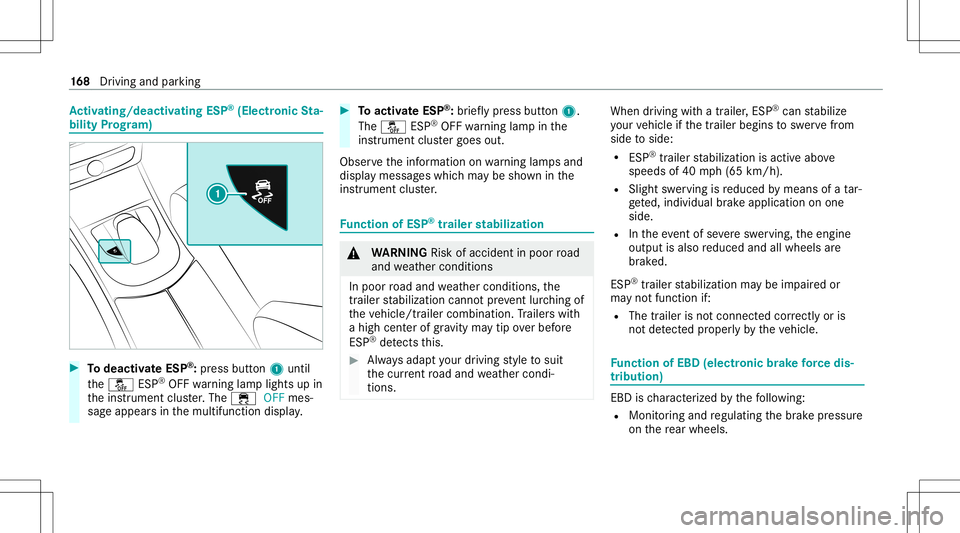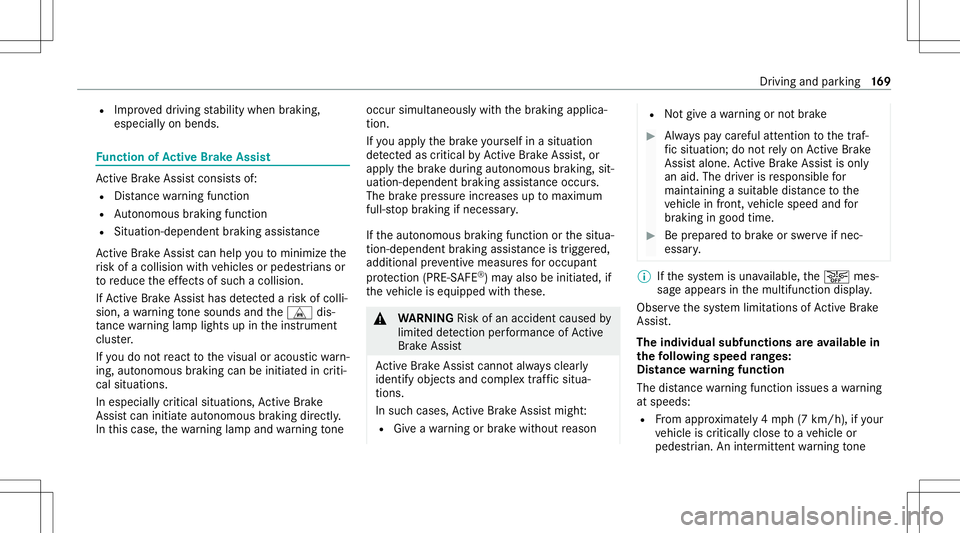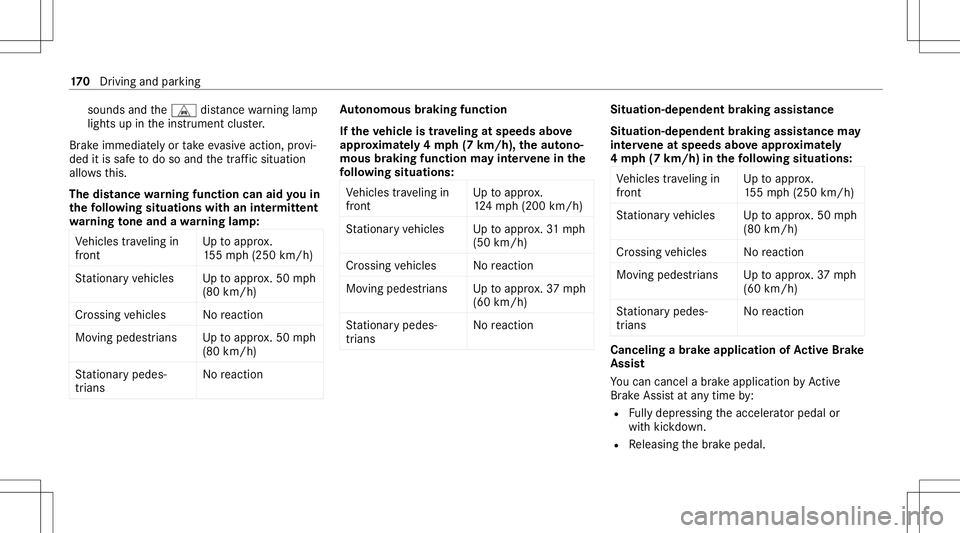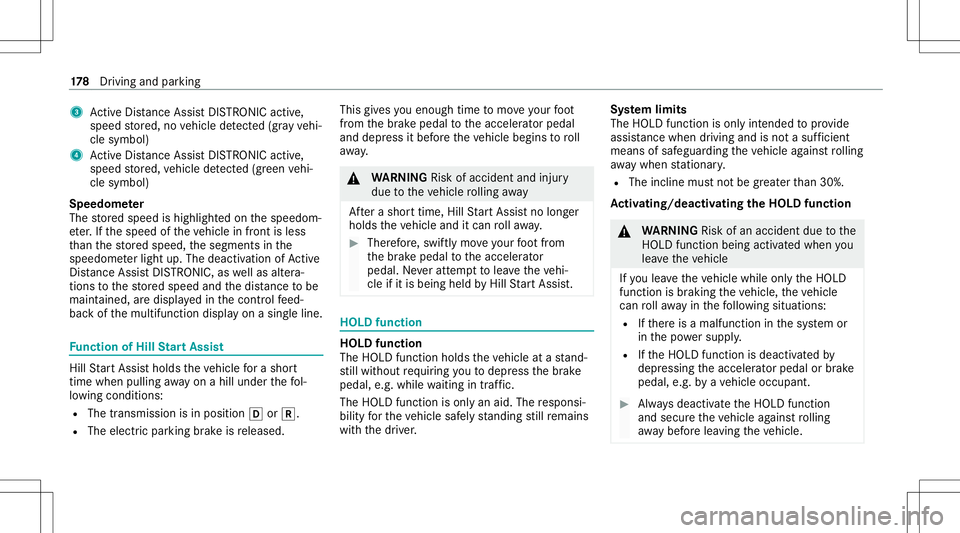2020 MERCEDES-BENZ G-CLASS light
[x] Cancel search: lightPage 169 of 530

ESP
®
can moni torand improve driving stabilit y
and tract ion inthefo llo wing situat ions,wit hin
ph ysical limit s:
R When pulling away on wetor slip pe ry road‐
wa y.
R When braking.
R Vehicl eswith traile rhitc h:Intrail er oper a‐
tion from spee dsof40 mph(6 5km/h) ,if th e
ve hicle/tr ailercombination beginstosw ay
fr om side toside.
If th eve hicle deviat esfrom thedir ect ion desir ed
by thedr iver ,ES P®
can stabiliz eth eve hicle by
int erve ning inthefo llo wing ways:
R One ormor ewheels arebr ak ed.
R The engine outputisadap tedaccor dingto
th esituation .
ES P®
is deactiv ated ifth e00BB ESP®
OFF warn‐
ing lam plight sup con tinuousl yin theins trument
clus ter.
Obser vethefo llo wing pointswhen ESP®
is deac‐
tiv ated:
R Drivin gst abilit ywill nolongerbe improve d. R
Vehicl eswith traile rhitc h:Stabiliz ationof
th eve hicle/tr ailercombination isno long er
activ e.
R The drive wheels couldspin.
R ETS/4E TStracti oncontr olisstill act ive.
% When ESP®
is deact ivat ed, youar est ill assis‐
te dby ESP ®
wh en braki ng.
If th e00E5 ESP®
wa rning lam pflashes inthe
ins trumen tclus ter,one orseveralve hicle wheels
has reac hed itsgrip limit :
R Adaptth edr iving style to suit thepr ev ailin g
ro ad and weather condition s.
R Donotdeac tivateES P®
unde ran ycir cum ‐
st anc es.
R Onlydepr esstheacceler ator pedal asfaras
is necessar y.
It ma ybe bes tto deactiv ateES P®
in thefo llo w‐
ing situat ions:
R When usingsnowch ains .
R Indeep snow .
R Onsand orgrave l. %
Spin ningth ewheels results inacutting
action, whichenhances traction.
If th e00E5 ESP®
wa rning lam plight sup con tinu‐
ousl y,ESP ®
is no tav ailable duetoamalf unction.
Obse rveth efo llo wing informatio n:
R Warning and indic ator lam ps(/ page47 5)
R Display messa ges(/ page42 7)
ET S/4ET S(Ele ctronic Tractio nSy stem)
ET S/ 4ETS tracti oncontr olispa rtof ESP ®
and
mak esitpossible topull away and accelerat eon
a slippe ryroadw ay.
ET S/4ET Scan impr ovetheve hicle's traction by
int erve ning inthefo llo wing ways:
R The drive wheels arebr ak ed individually if
th ey spin.
R Mor edr ive to rq ue istrans ferred tothewheel
or wheels withtra ction. Dr
iving andparking 16
7
Page 170 of 530

Ac
tiv atin g/deac tivatin gES P®
(E lectr onicSta‐
bil ity Prog ram) #
Todeac tivateES P®
:pr ess button 1 unti l
th e00BB ESP®
OFF warning lam plight sup in
th eins trument cluster.The 00E5 OFFmes‐
sag eappear sin themultifunc tiondispla y. #
Toactiv ateESP ®
:br ief lypress butt on1.
The 00BB ESP®
OFF warning lam pin the
ins trumen tclus tergoes out.
Obser vetheinf ormation onwarning lam psand
displa ymess ages whic hma ybe sho wninthe
ins trumen tclus ter. Fu
nction ofESP ®
trailer stabil izatio n &
WARNIN GRisk ofacci dent inpoo rro ad
and weather condition s
In poor road and weather condition s,the
tr ai le rst abiliz ationcan notpr eve ntlurc hing of
th eve hicle/tr ailercombination. Trailer swit h
a high centerof grav ity ma ytip over bef ore
ES P®
de tects this. #
Alw aysadap tyo ur drivin gst yle to suit
th ecur rent road and weather condi‐
tio ns. When
drivin gwit hatrailer ,ES P®
can stabiliz e
yo ur vehicle ifth etrailer begins tosw erve from
side toside:
R ESP ®
traile rst abiliz ationis act ive abo ve
speeds of40 mph(65 km/h).
R Slight swerving isreduced bymeans ofata r‐
ge ted, individual brak eapplication onone
side.
R Intheeve ntofsevere sw erving, theengine
output isalso reduced andallwheels are
br ak ed.
ES P®
tra iler stabiliz ationma ybe impair edor
ma yno tfun ction if:
R The trailer isno tcon nectedcor rectl yor is
no tde tected prope rly by theve hicle. Fu
nction ofEBD (electr onicbrak efo rc edis‐
tr ibut ion) EB
Dis ch aract erize dby thefo llo wing:
R Mon itor ing and regulating thebr ak epr essur e
on there ar wheels . 16
8
Driving and parking
Page 171 of 530

R
Improve ddr iving stabilit ywhen brakin g,
espe ciallyon ben ds. Fu
nction ofActiv eBr ak eAs sist Ac
tiveBr ak eAssi stconsi stsof:
R Distance warning func tion
R Autonomo usbraki ng func tion
R Situ ation-d epend ent braki ng assist anc e
Ac tiveBr ak eAssi stcan helpyo uto minimize the
ri sk ofacollision withve hicles orpedes trians or
to reduce theef fects ofsuch acol lision .
If Ac tiveBr ak eAssi sthas detected arisk ofcolli‐
sion, awa rning tone sou nds and theL dis‐
ta nce warning lam plight sup intheins trument
clus ter.
If yo udo notre act tothevisual oracous ticwarn‐
ing, autono mous brakin gcan beinit iated incriti‐
cal situat ions.
In espec iallycr itic alsituat ions,Ac tiveBr ak e
Assi stcan initia te aut onomo usbrakin gdir ect ly.
In this case, thewa rning lam pand warning tone occu
rsi mu ltane ously with thebr aking applica‐
tion .
If yo uappl yth ebr ak eyo urself inasit uatio n
de tected ascritical byActiveBr ak eAssi st,or
appl yth ebr ak edur ing autonomous braking, sit‐
uation- dependent braking assistance occu rs.
The brak epr essur eincr eases uptomaximu m
full -sto pbr aking ifnec essar y.
If th eaut onomous braking function orthesitua‐
tion -dependen tbr aking assistance istrig ge red,
additional preve ntiv emea suresfo roccupa nt
pr otect ion (PRE-S AFE®
)ma yalso beinitiat ed,if
th eve hicle iseq uipped withth ese. &
WARNIN GRisk ofan acci dent caused by
limit eddetection perform anc eof Active
Br ak eAssi st
Ac tiveBr ak eAssi stcanno tal wa ys cle arly
id entify objectsand complex traf fic situ a‐
tions .
In such case s,Ac tiveBr ak eAssi stmight :
R Giveawa rning orbrak ewit hout reason R
Notgiv eawa rning ornotbr ak e #
Alw ayspa ycar eful attention tothetra f‐
fi c situ ation; donotre ly on ActiveBr ak e
Assi stalon e.Ac tiveBr ak eAssi stisonl y
an aid. Thedriver isresponsible for
maint ainingasui table distance tothe
ve hicle infront, vehicle speed andfor
br aking ingood time. #
Beprepar edtobrak eor sw erve ifnec ‐
essar y. %
Ifth esy stem isuna vailable, the00D4 mes‐
sag eappear sin themultifunc tiondispla y.
Obser vethesy stem limit ations ofActiveBr ak e
Assi st.
The indiv idua lsub functionsar eav ailab lein
th efo llo wing speed rang es:
Dis tance warning funct ion
The distance warning func tion issues awa rning
at speeds:
R From appr oximat ely4 mp h(7 km/h), ifyo ur
ve hicle iscritically closetoave hicle or
pedes trian. Anintermitt entwarning tone Dr
iving and parking 16
9
Page 172 of 530

sounds
andtheL distance warning lam p
light sup intheins trument cluster.
Br ak eimme diat ely ortake eva siveaction, prov i‐
ded itis saf eto do soand thetra ffic situat ion
allo wsthis.
Th edis tance warning funct ioncan aidyouin
th efo llo wing situations withan intermit tent
wa rning tone and awa rning lam p:
Ve hicles trave ling in
fr ont Up
toappr ox.
15 5mp h(2 50 km/h)
St atio naryve hicles Uptoappr ox.50 mph
(80 km/ h)
Cr ossin gve hicles Noreact ion
Mo vingpedes trians Uptoappr ox.50 mph
(80 km/ h)
St atio narypedes ‐
tr ians No
reaction Au
tonomous braking function
If th eve hicl eis trave ling atspeed sabo ve
appr oxima tely 4mp h(7 km /h),the autono‐
mo usbraki ng fun ction ma yin te rv ene inthe
fo llo wing situations:
Ve hicles trave ling in
fr ont Up
toappr ox.
12 4mp h(2 00 km/h)
St atio naryve hicles Uptoappr ox.31 mp h
(50 km/ h)
Cr ossin gve hicles Noreact ion
Mo vingpedes trians Uptoappr ox.37 mph
(60 km/ h)
St atio narypedes ‐
tr ians No
react ion Sit
uation -depen dent brak ing assistance
Sit uation -depen dent brak ing assistance may
int erve ne atspeeds aboveappr oxima tely
4 mp h(7 km /h)in thefo llo wing situations:
Ve hicles trave ling in
fr ont Up
toappr ox.
15 5mp h(2 50 km/h)
St atio naryve hicles Uptoappr ox.50 mph
(80 km/ h)
Cr ossin gve hicles Noreact ion
Mo vingpedes trians Uptoappr ox.37 mph
(60 km/ h)
St atio narypedes ‐
tr ians No
react ion Cancel
ingabr ak eap plica tionofActiv eBr ak e
As sist
Yo ucan cancelabr ak eapplic ationby Active
Br ak eAssi stat anytim eby :
R Fully depr essin gth eacceler ator pedal or
wit hkic kdo wn.
R Releasing thebr ak epedal. 17
0
Driving and parking
Page 173 of 530

Ac
tiveBr ak eAssi stma ycancel thebr ak eappli‐
cation whenoneofthefo llo wing condition sis
fulf illed:
R Youman euvertoavo idtheobs tacle .
R The reisno long erarisk ofcollision.
R Anobs tacle isno long erdetected infront of
yo ur vehicle.
Sy stem limit s
The system maybe impair edorma yno tfunc tion
in thefo llo wing situat ions:
R Insno w,rain, fog, hea vyspr ay,if th er eis
gl ar e, indir ect sunlight oringrea tly varying
ambien tlight .
R Ifth esensor sar edir ty,fo gg ed up, damag ed
or covered.
R Ifth esensor sar eim pair eddue tointerfer‐
ence from other radar sour ces, e.g.stro ng
ra dar reflect ions inpar king garage s.
R Ifaloss oftirepr essur eor afa ulty tirehas
been detected and displ ayed. R
Fullsy stem perform anc eis no tav ailable fora
fe w sec ond saf te rswitc hingontheignition
or afte rdr iving off.
R Incom plextraf fic situ ations whereobject s
cann otalw aysbe clear lyident ified.
R Forpede strians orvehicles ifth ey mo ve
qu ickl yint oth esensor detection rang e.
R Forpede strians who arehidde nby other
object s.
R Ifth etypical outline ofapedes trian cann ot
be distinguished from thebac kground.
R Ifapedes trian isno tde tected assuch ,e.g.
due tospecial clothing orother object s.
R Onbends withatight radius.
% The ActiveBr ak eAssi stsensor system
adjus tsaut omaticall ywhile acer tain dis‐
ta nce isdriven afte rth eve hicle hasbeen
deliv ered. During this teac h-in per iod, Active
Br ak eAssi stisuna vailable oronl ypar tiall y
av ailable. Se
tting Activ eBr ak eAs sist Multimedia
system:
4 Vehicle 5
k Assist ance
5 Act ive Brak eAssist
The follo wing settings areav ailable:
R Early
R Medium
R Late #
Select ase tting .
% Your sele ction isretained when theve hicle is
ne xt star ted.
Deactiv atingActiv eBr ak eAs sist
% Itis recomme ndedthat youalw ayslea ve
Ac tiveBr ak eAssi stact ivat ed. #
Select Off.
The distance warning func tion andtheaut on‐
omous braking function aredeactiv ated.
When theve hicle isne xt star ted, theMedium
se tting isaut omaticall yselect ed. Dr
iving andparking 17
1
Page 174 of 530

%
IfAc tiveBr ak eAssi stisdeact ivat ed, the
00D4 symbol appearsinthest atus barofthe
multifu nctiondisplay. Speed
controlcruise contr ol Fu
nction ofcruise contr ol
Cr uise controlre gulat esthespeed totheva lue
selec tedby thedr iver .
If yo uacc elerat eto ove rtak e, forex am ple, the
st or ed speed isno tdele ted. Ifyo ure mo veyour
fo ot from theacceler ator pedal afte rove rtakin g,
cr uise control will resume speed regulation back
to thestor ed speed.
Cr uise controlis oper ated using thecor respond‐
ing steer ing wheel buttons. Youcan stor ean y
speed above15 mp h(2 0km/h) uptothemaxi‐
mum speed.
If yo ufa ilto adap tyo ur drivin gst yle, cruise con‐
tr ol can neither reduce therisk ofan accident
nor override thelaws ofphysics. Itcan nottak e
int oacc ount road, weather ortraf fic condi tions.
Cr uise contr olisonly anaid. The driver is
re sponsible formaint ainingasaf edis tance to th
eve hicle infront, forve hicle speed, forbr aking
in good timeandforst ay ing inlane.
Displa yson themu ltifunct iondisp lay
The status ofcruise control and thestor ed
speed aresho wninthemultifunc tiondispla y. 1
Cruise contro lis selec ted
2 Spee dis save d, cruise control isdeactiv ated
3 Speed issave d, cruise control isactiv ated
% The segmen tsbetween thestor ed speed and
th eend ofthesegment displaylight upin
th espeedome ter. Sy
stem limit s
Cr uise control ma ybe unable tomaint ainthe
st or ed speed onuphill gradients. Thestor ed
speed isresumed whenthegr adient evensout.
Ch ang eint oalowe rge ar ingood timeon long
and steep downhill gradients. Take par ticular
no te ofthis when drivin galaden vehicle. By
doing so,youwill mak euse ofthebr aking effect
of theengine. Thisrelie vesth eload onthebr ak e
sy stem and preve nts thebr ak es from overheat‐
ing and wearing tooqu ickl y.
Do notus ecr uise contr olinthefo llo wing situa‐
tion s:
R Intraf fic situ ations whichrequ ire freq uent
ch ang esofspee d,e.g .in hea vytraf fic, on
wi nding roads.
R Onslippe ryroads. Accel erati ng can cause
th edr ive wheels tolose tract ion and the
ve hicle could then skid.
R Ifyo uar edr ivin gwhen visibilit yis poor . 17
2
Driving and parking
Page 176 of 530

#
Todeac tivatecr uis eco ntr ol:pr ess rock er
switc h1 down.
% Ifyo ubr ak e, deac tivateES P®
or ifES P®
int erve nes, cruise contr olisde acti vated. Ac
tiv eDi stance AssistDI ST RO NIC Fu
nction ofActiv eDi stance Assist
DI ST RO NIC
Ac tiveDis tance AssistDIS TRONI Cma intains the
se tspeed onfree-f lowing roads. Ifve hicles in
fr ont arede tected, these tdis tance ismai n‐
ta ined, ifnec essar y,unt ilth eve hicle comes toa
halt. Thevehicle acceler ates orbrak es depend‐
ing onthedis tance totheve hicle infront and
th ese tspeed. Thespeed (inthera ng ebe twee n
15 mp h(2 0km/h) and120mp h(2 00 km/h) )
and thedis tance totheve hicle infront arese t
and save don thesteer ing wheel.
Ot her featur esofActiveDis tance Assist
DIS TRONI C:
R Adjus tsthedr iving style depending onthe
select eddrive pr ogr am (fuel efficie nt, com‐
fo rtable ordynam ic)(/ page14 1) R
Initia tesacceler ationtothestor ed speed if
th etur nsignal indicat orisswitc hedonto
ch ang eto theove rtakin glane .
Ac tiveDis tance AssistDIS TRONI Cis only anaid.
The driver isresponsible forke eping asaf edis‐
ta nce totheve hicle infront, forve hicle speed
and forbr aking ingood time.
Sy stem limit s
The system maybe impair edorma yno tfunc tion
in thefo llo wing situat ions:
R Insno w,rain, fog, hea vyspr ay,if th er eis
gl ar e, indir ect sunlight oringreat lyvarying
ambien tlight .
R Ifth er eis swir ling dust,e.g. when driving off-
ro ad oron san dysur faces.
R The windsh ield inthear ea ofthecamer ais
dir ty,fo gg ed up, damag edorcovered.
R Ifth era dar sensor sar edir tyor covered.
R Inpar kingga rage sor on roads withsteep
uphill ordownhill gradients.
R Ifth er ear enar row vehicles infront, suchas
bicy cles ormo torcyc les. In
addition ,on slipper yro ads, brakin gor acc el‐
er atin gcan caus eon eor severalwheels tolose
tr act ion and theve hicle could then skid.
Do notuse ActiveDis tance AssistDIS TRONI Cin
th ese situation s. &
WARNIN GRisk ofacci dent from acce ler‐
ati on orbraki ng byActiveDis tance
Assi stDIS TRONI C
Ac tiveDis tance AssistDIS TRONI Cma yacc el‐
er ateor brak ein thefo llo wing cases ,fo r
ex am ple:
R Ifth eve hicle pullsaway usin gAc tiveDis ‐
ta nce AssistDIS TRONI C.
R Ifth estor ed speed iscalled upand is
consider ablyfa ster or slo werth an the
cur rently driven spe ed.
R IfAc tiveDis tance AssistDIS TRONI Cno
lo ng er detects ave hicle infront ordoes
no tre act toreleva nt objects. #
Alw ayscar efully observethetraf fic con‐
di tions andbeready tobrak eat all
times. 17
4
Driving and parking
Page 180 of 530

3
ActiveDis tance AssistDIS TRONI Cacti ve,
speed stor ed, novehicle detected (gray vehi‐
cle symbol)
4 ActiveDis tance AssistDIS TRONI Cacti ve,
speed stor ed, vehicle detected (green vehi‐
cle symbol)
Speedome ter
The stor ed speed ishighlight edon thespeedom‐
et er.If th espeed oftheve hicle infront isless
th an thestor ed speed, thesegment sin the
speedome terlig ht up. The deactivation ofActive
Dis tance AssistDIS TRONI C,as wellas altera‐
tion sto thestor ed speed andthedis tance tobe
maint ained, aredispla yedin thecon trol feed‐
bac kof themultifunc tiondispla yon asing leline. Fu
nction ofHill StartAss ist Hill
StartAs sis tholds theve hicle fora shor t
time when pulling away on ahill under thefo l‐
lo wing condition s:
R The transmissio nis in posit ion005Bor005E.
R The elect ric pa rking brak eis released. This
gives youen ough timeto mo veyour foot
fr om thebr ak epedal totheaccelera torpeda l
and depr essitbef oreth eve hicle begins toroll
aw ay. &
WARNIN GRisk ofacci dent andinjury
due totheve hicle rolling away
Af tera shor ttime, HillStartAs sis tno longer
holds theve hicle anditcan rollaw ay. #
Ther efor e, swif tly mo veyour foot from
th ebr ak epedal totheacceler ator
pedal. Neveratt em pttolea vetheve hi‐
cle ifit is being heldbyHillSt artAs sis t. HOLD
functi on HOLD
functi on
The HOL Dfun ction holds theve hicle atast and‐
st ill wit hout requ iring youto depr essthebr ak e
pedal, e.g.while waitin gin traf fic.
The HOLD functionisonly anaid. The responsi‐
bility forth eve hicle safely standi ngstill remains
wit hth edr iver . Sy
stem limit s
The HOL Dfun ction isonl yint end edtoprov ide
assis tance when drivi ng and isno ta su fficien t
mean sof saf eguar dingtheve hicle agains tro lling
aw ay when statio nary.
R The incline mustno tbe great erthan 30%.
Ac tiv atin g/deac tivatin gthe HOL Dfun ction &
WARNIN GRisk ofan acci dent dueto the
HOLD functio nbei ng activ ated whe nyo u
lea vetheve hicle
If yo ulea vetheve hicle while onlyth eHOLD
func tion isbraking theve hicle, theve hicle
can rollaw ay inthefo llo wing situat ions:
R Ifth er eis amalfunct ioninthesy stem or
in thepo we rsupp ly.
R Ifth eHOLD function isdeactiv ated by
depr essing theacceler ator pedal orbrak e
pedal, e.g.byave hicle occupant. #
Alw aysdeactiv ateth eHOLD function
and secur eth eve hicle agains tro lling
aw ay bef orelea ving theve hicle. 17
8
Driving and parking